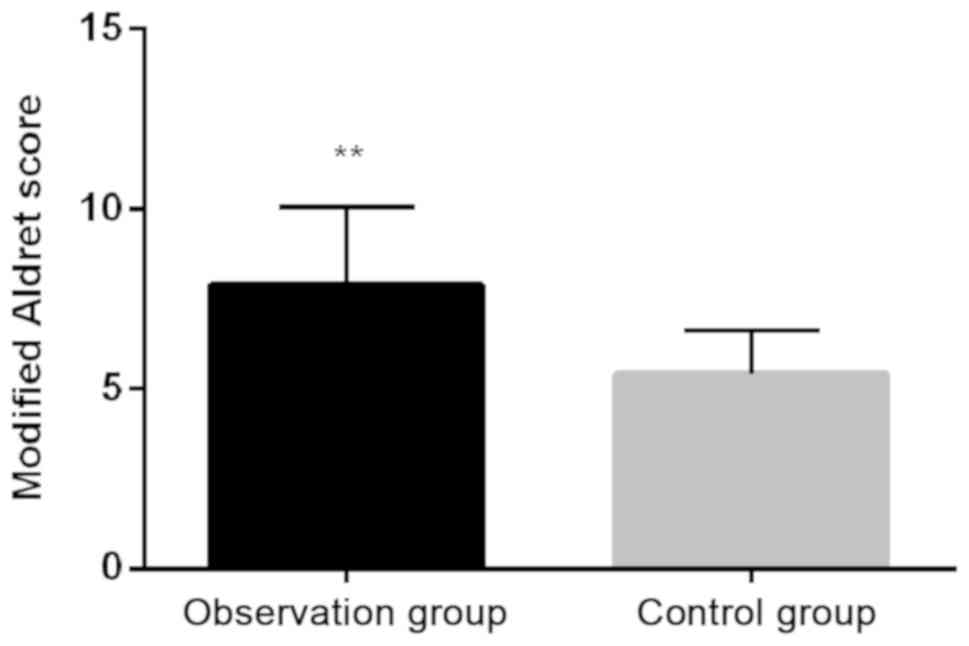|
1
|
Vanis-Vatrenjak S, Mesic A, Abdagic I,
Mujezinovic D and Zvizdic Z: Quality and safety of general
anesthesia with propofol and sevoflurane in children aged 1–14
based on laboratory parameters. Med Arh. 69:218–221. 2015.
View Article : Google Scholar
|
|
2
|
Abdel-Ma'boud MA: Effect of
dexemeditomedine and propofol on the prevention of emergence
agitation following sevoflurane anesthesia in Egyptian children. J
Egypt Soc Parasitol. 44:687–694. 2014. View
Article : Google Scholar : PubMed/NCBI
|
|
3
|
Erturk E, Topaloglu S, Dohman D, Kutanis
D, Beşir A, Demirci Y, Kayir S and Mentese A: The comparison of the
effects of sevoflurane inhalation anesthesia and intravenous
propofol anesthesia on oxidative stress in one lung ventilation.
BioMed Res Int. 2014:3609362014. View Article : Google Scholar : PubMed/NCBI
|
|
4
|
Anderson RE, Barr G, Assareh H and
Jakobsson J: The AAI index, the BIS index and end-tidal
concentration during wash in and wash out of sevoflurane.
Anaesthesia. 58:531–535. 2003. View Article : Google Scholar : PubMed/NCBI
|
|
5
|
Wen XR, Fu YY, Liu HZ, Wu J, Shao XP,
Zhang XB, Tang M, Shi Y, Ma K, Zhang F, et al: Neuroprotection of
sevoflurane against ischemia/reperfusion-induced brain injury
through inhibiting JNK3/caspase-3 by enhancing Akt signaling
pathway. Mol Neurobiol. 53:1661–1671. 2016. View Article : Google Scholar : PubMed/NCBI
|
|
6
|
Gottschalk A, Berkow LC, Stevens RD,
Mirski M, Thompson RE, White ED, Weingart JD, Long DM and Yaster M:
Prospective evaluation of pain and analgesic use following major
elective intracranial surgery. J Neurosurg. 106:210–216. 2007.
View Article : Google Scholar : PubMed/NCBI
|
|
7
|
Henderson F, Absalom AR and Kenny GN:
Patient-maintained propofol sedation: A follow up safety study
using a modified system in volunteers. Anaesthesia. 57:387–390.
2002. View Article : Google Scholar : PubMed/NCBI
|
|
8
|
Mathy-Hartert M, Mouithys-Mickalad A,
Kohnen S, Deby-Dupont G, Lamy M and Hans P: Effects of propofol on
endothelial cells subjected to a peroxynitrite donor (SIN-1).
Anaesthesia. 55:1066–1071. 2000. View Article : Google Scholar : PubMed/NCBI
|
|
9
|
Hubbard RC, Naumann TM, Traylor L and
Dhadda S: Parecoxib sodium has opioid-sparing effects in patients
undergoing total knee arthroplasty under spinal anaesthesia. Br J
Anaesth. 90:166–172. 2003. View Article : Google Scholar : PubMed/NCBI
|
|
10
|
Aldrete JA: Postanesthesia recovery scores
and postoperative hypoxemia. Anesth Analg. 67:1016–1017. 1988.
View Article : Google Scholar : PubMed/NCBI
|
|
11
|
Ortiz J, Chang LC, Tolpin DA, Minard CG,
Scott BG and Rivers JM: Randomized, controlled trial comparing the
effects of anesthesia with propofol, isoflurane, desflurane and
sevoflurane on pain after laparoscopic cholecystectomy. Braz J
Anesthesiol. 64:145–151. 2014. View Article : Google Scholar
|
|
12
|
Liang C, Ding M, Du F, Cang J and Xue Z:
Sevoflurane/propofol coadministration provides better recovery than
sevoflurane in combined general/epidural anesthesia: A randomized
clinical trial. J Anesth. 28:721–726. 2014. View Article : Google Scholar : PubMed/NCBI
|
|
13
|
Kuenszberg E, Loeckinger A, Kleinsasser A,
Lindner KH, Puehringer F and Hoermann C: Sevoflurane progressively
prolongs the QT interval in unpremedicated female adults. Eur J
Anaesthesiol. 17:662–664. 2000. View Article : Google Scholar : PubMed/NCBI
|
|
14
|
Aggarwal S, Goyal VK, Chaturvedi SK,
Mathur V, Baj B and Kumar A: A comparative study between propofol
and etomidate in patients under general anesthesia. Braz J
Anesthesiol. 66:237–241. 2016. View Article : Google Scholar : PubMed/NCBI
|
|
15
|
Kanaya A, Kuratani N, Satoh D and Kurosawa
S: Lower incidence of emergence agitation in children after
propofol anesthesia compared with sevoflurane: A meta-analysis of
randomized controlled trials. J Anesth. 28:4–11. 2014. View Article : Google Scholar : PubMed/NCBI
|
|
16
|
Picard V, Dumont L and Pellegrini M:
Quality of recovery in children: Sevoflurane versus propofol. Acta
Anaesthesiol Scand. 44:307–310. 2000. View Article : Google Scholar : PubMed/NCBI
|
|
17
|
Rosen HD, Mervitz D and Cravero JP:
Pediatric emergence delirium: Canadian Pediatric Anesthesiologists'
experience. Paediatr Anaesth. 26:207–212. 2016. View Article : Google Scholar : PubMed/NCBI
|
|
18
|
Dennhardt N, Boethig D, Beck C, Heiderich
S, Boehne M, Leffler A, Schultz B and Sümpelmann R: Optimization of
initial propofol bolus dose for EEG Narcotrend Index-guided
transition from sevoflurane induction to intravenous anesthesia in
children. Paediatr Anaesth. 27:425–432. 2017. View Article : Google Scholar : PubMed/NCBI
|
|
19
|
Costi D, Ellwood J, Wallace A, Ahmed S,
Waring L and Cyna A: Transition to propofol after sevoflurane
anesthesia to prevent emergence agitation: A randomized controlled
trial. Paediatr Anaesth. 25:517–523. 2015. View Article : Google Scholar : PubMed/NCBI
|











